Newsletter: What the clean energy future looks like from a 262-foot wind turbine
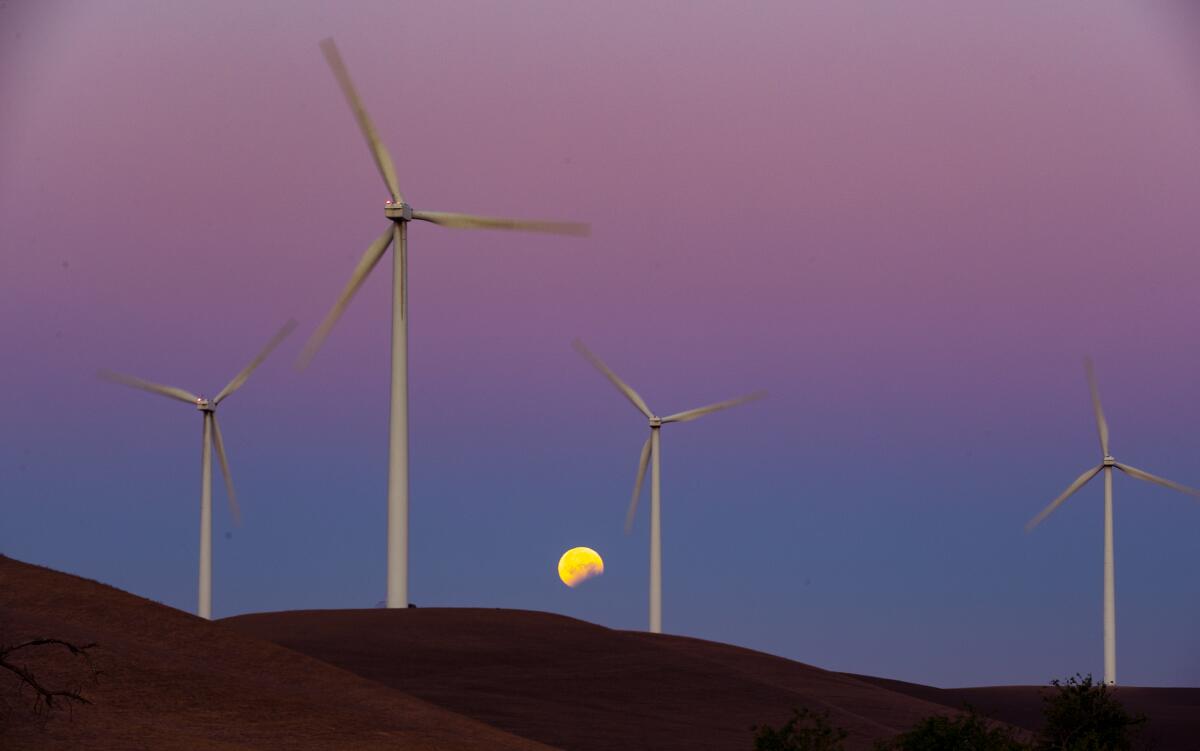
This is the June 24, 2021, edition of Boiling Point, a weekly newsletter about climate change and the environment in California and the American West. Sign up here to get it in your inbox.
Hundreds of feet above the ground, suspended by ropes and battered by powerful winds, Matthew Kelly is living his best life.
Kelly is a wind turbine technician, and my colleague Brian van der Brug recently took pictures of him repairing a fiberglass blade at a wind farm in California’s Montezuma Hills, at the northeastern end of the Bay Area. Brian’s pictures are worth a thousand words and then some. Here’s a shot of Kelly perched on the damaged blade, putting his rock climbing background to good use:
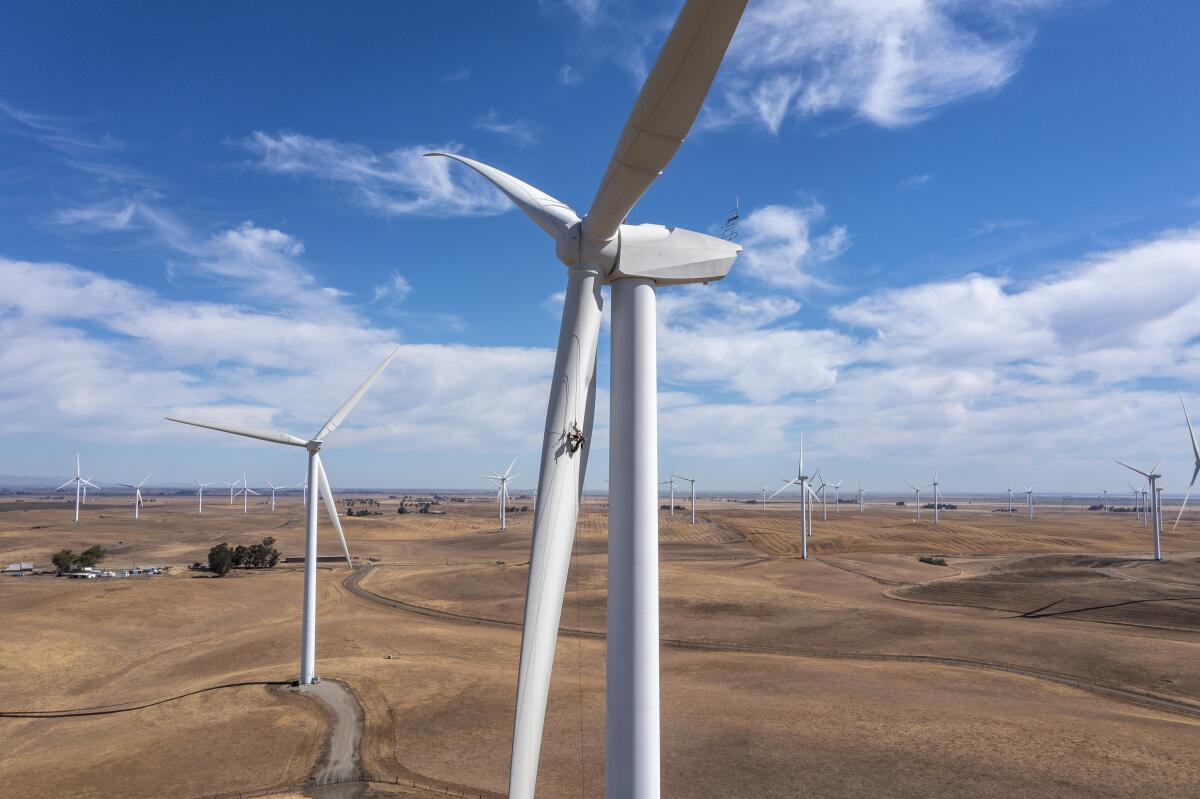
And here’s Kelly lowering himself to the ground after 10 hours suspended from the top of the 262-foot tower:
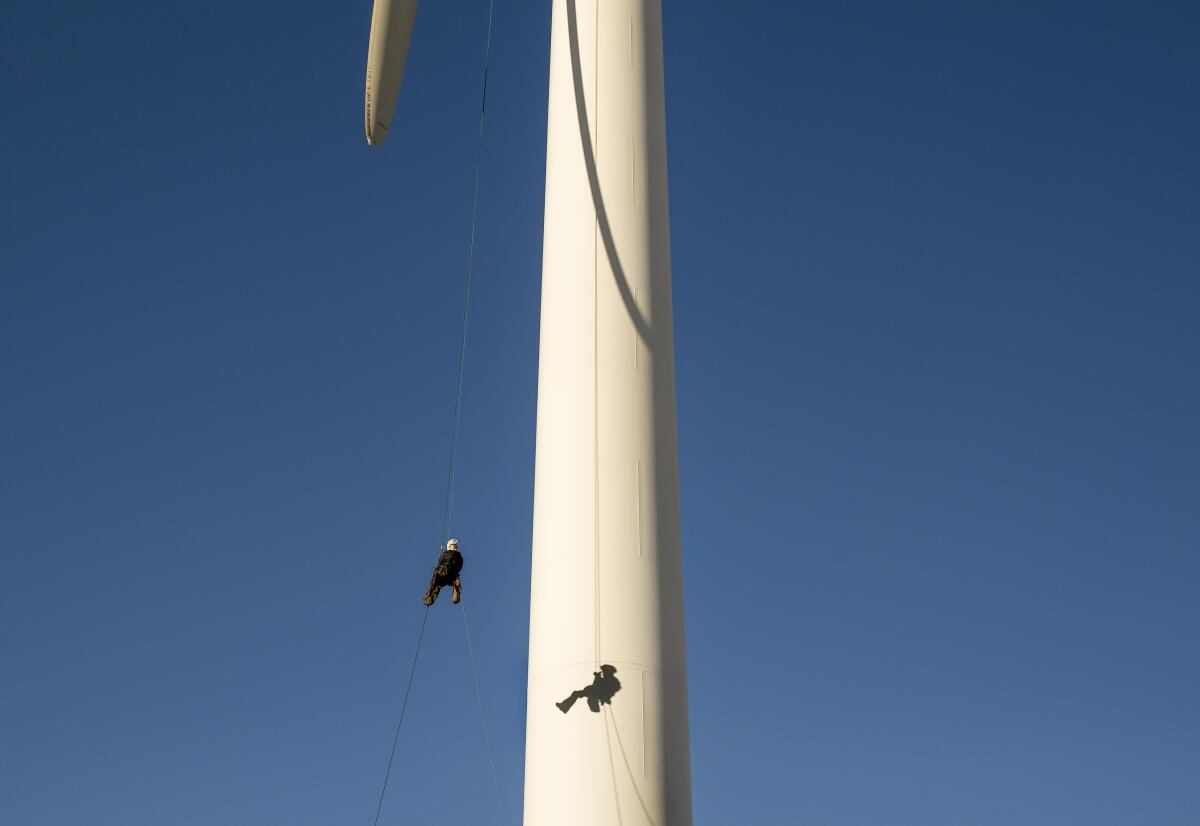
These photos took my breath away. They also made me think about two topics I’ve covered recently: The future of energy jobs as the United States transitions from fossil fuels to renewables, and how wind and solar farms can dramatically reshape landscapes.
Let’s start with jobs.
The U.S. Bureau of Labor Statistics projects that wind turbine service technician will be the country’s fastest-growing occupation this decade, with employment expected to increase by 61%, from 7,000 to 11,300 jobs. (Solar panel installer is third on the fastest-growth list, with a projected 51% increase in jobs.) Median pay for a wind turbine technician is $56,230 per year, or $27.03 per hour — well above the national median wage of $41,950, or $20.17 per hour, according to the federal agency.
Kelly works for Rope Partner, which is based in Santa Cruz and was founded by rock climber Chris Bley in 2001. Bley was inspired by a chance encounter in Joshua Tree National Park with two German climbers who made a living scaling construction sites and churches that needed repairs. His timing couldn’t have been better, given the rapid growth of the American wind energy industry.
Kelly found his way to the “rope access” profession in 2018, after graduating college with a degree in environmental science and policy. Here he is again on that blade at the Shiloh II wind farm, which is owned by San Diego-based EDF Renewables, a subsidiary of the French electric utility EDF. You can see the repair-in-process Kelly has been working on below his feet:
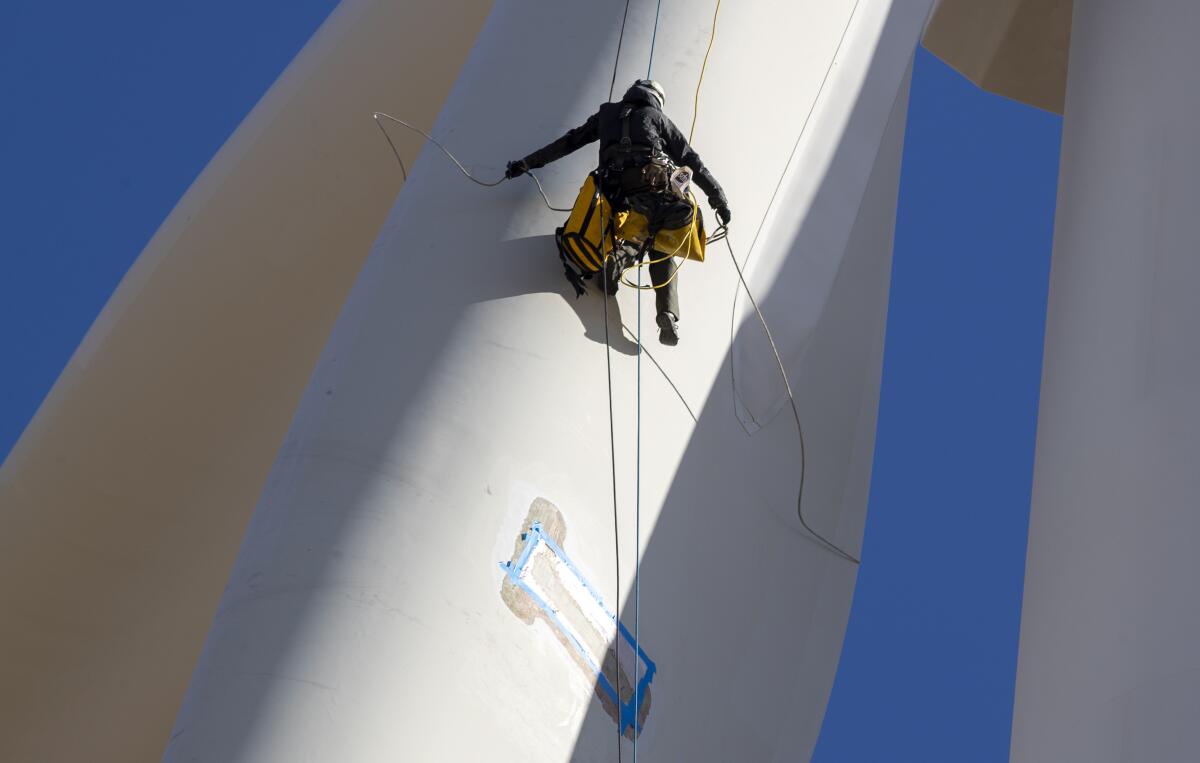
Rope Partner has a roster of about 100 technicians, according to the company’s vice president of business development, Lucas Llado. Many of them are climbers, rafters, skiers and other adventurous outdoors types who spend part of the year scaling wind turbines. The winter months are the slowest for repairs, with jobs picking up as the weather improves in the spring.
“These guys are nomadic by nature,” Llado said. “It’s kind of a lifestyle alignment that allows these technicians to make a living working off of rope, and also getting to see parts of the country or the world, wherever we’re working.”
At the high end, Llado said, top-level technicians can make six-figure salaries, often without a college education. And the work is crucial to the clean energy transition. Wind turbine blades erode over time, reducing power production. They can crack from the stress they’re under, or suffer damage during transportation. Lightning strikes can also require fixes.
“It’s like your car. You need to maintain it to perform,” Llado said. “You can do it preemptively and avoid a large bill or wait for something to break.”
That’s where Kelly and his coworkers come in. Here he is climbing a ladder within a 262-foot tower at Shiloh II. Once he emerges at the top, he’ll rappel down the length of the 148-foot blade in need of repair:
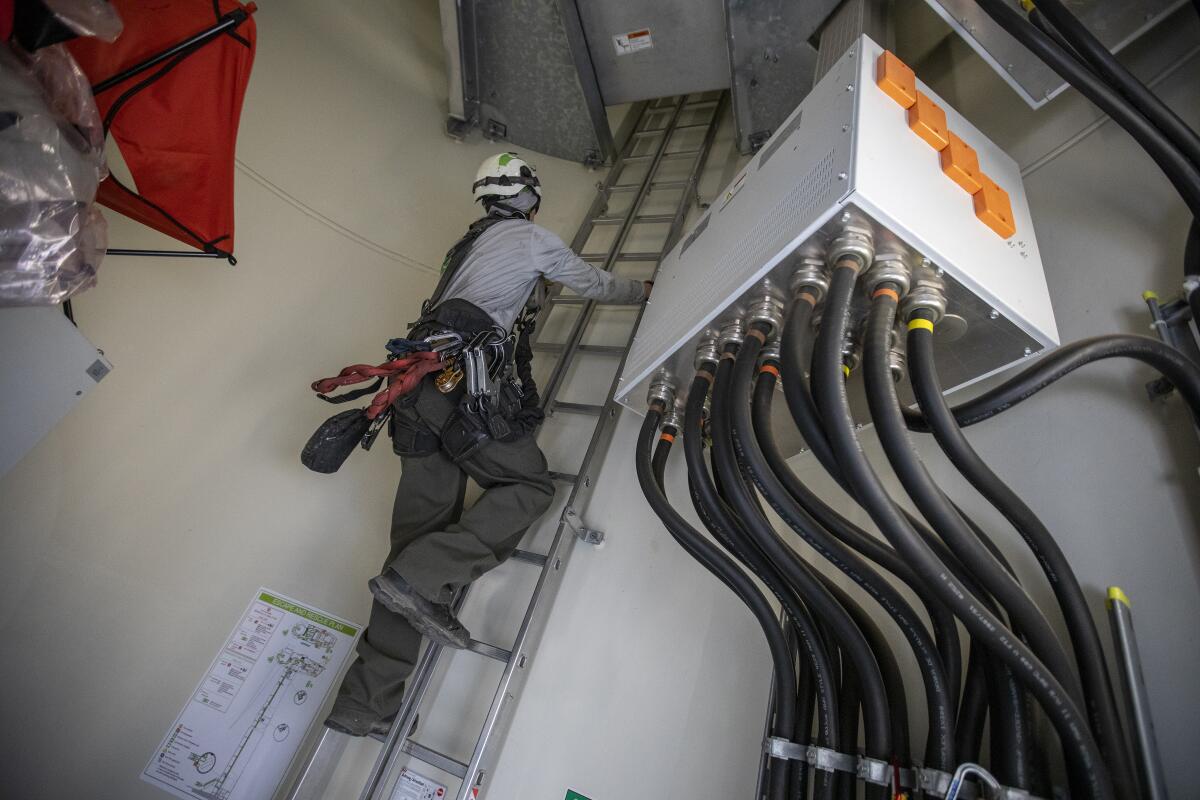
Here he is alongside the fiberglass blade, preparing to receive a bucket of tools and supplies being lifted from below:
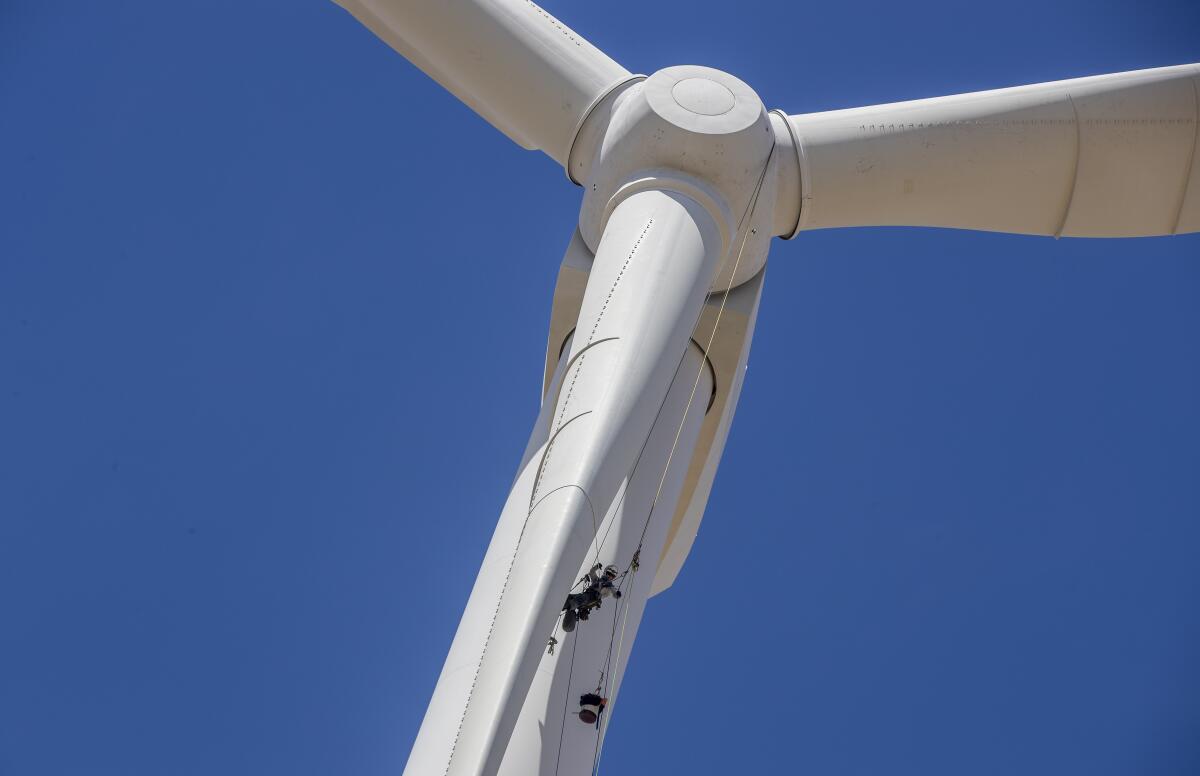
And here’s his colleague Lloyd Hardin down on the ground, helping to manage the ropes as the bucket gets lifted up:
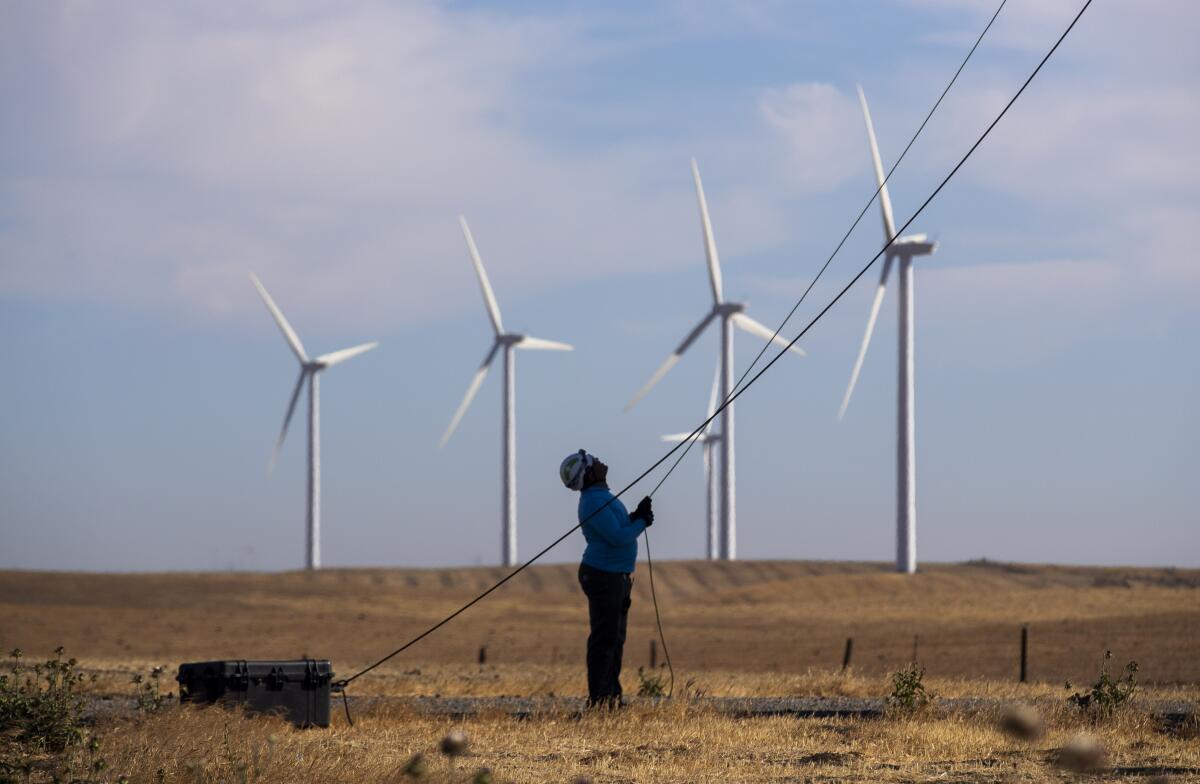
Kelly told me this is his “fourth season” scaling wind turbines, and it’s safe to say he enjoys his job. He likes being able to work half the year and “explore other things” the rest of the time. He’s also a fan of the sweeping views from the tops of the towers.
“It’s pretty great to turn my back or turn my head and have a little lunch break right up in the air,” he said. “It’s a pretty unparalleled situation. And just being at the whims of the element — the winds, the rains, the cold, the hot.”
I recently wrote in this newsletter about the aesthetics of wind and solar farms, and talking with Kelly brought me back to that debate. Are large-scale renewable energy facilities a beautiful sign of a better future, or ugly eyesores on otherwise gorgeous landscapes? And will opposition to these facilities based on their visual impacts slow the transition away from fossil fuels?
Admiring Brian’s photos, it’s hard for me not to think the wind machines look nice — especially with sheep in the foreground, and later with the blood moon lunar eclipse in the background:
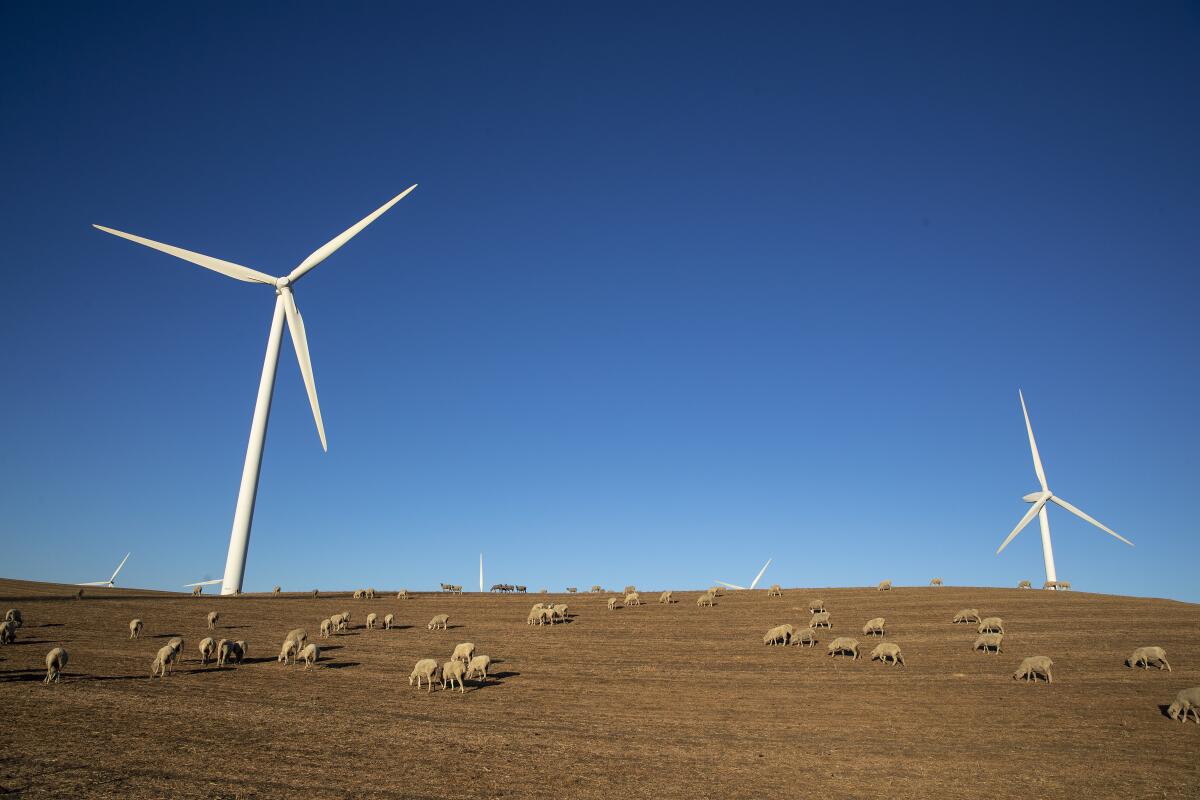
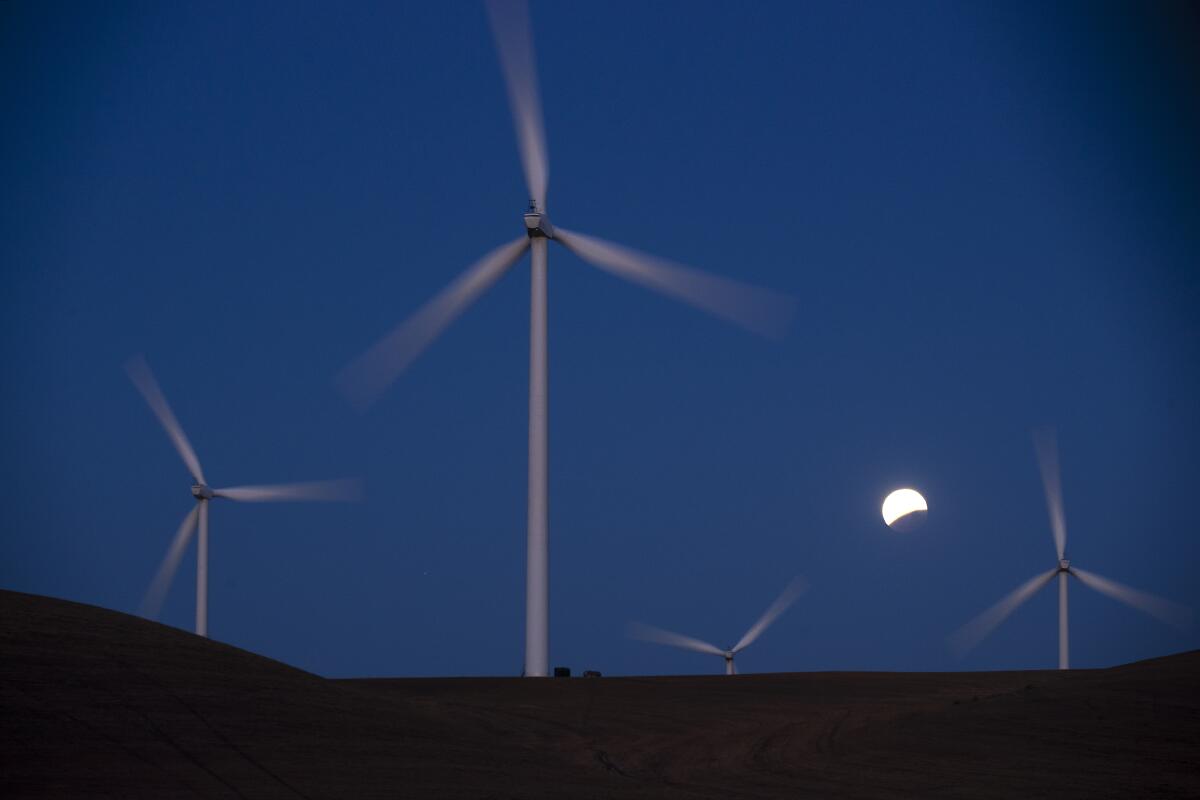
That said, I live in a big city, not a rural town where people expect uninterrupted viewsheds. There’s an incredible diversity of opinions on this topic, as the responses I received to last month’s newsletter showed. I shared many of the responses in this Twitter thread, from the emailer who compared opposing renewable energy over visual impacts to “complaining that your tea has gone cold while the Titanic sinks” to the many readers who argued that solar panels should go on rooftops, not wild landscapes.
“A core part of being an environmentalist is preserving the natural beauty of the scenic landscape for present and future generations,” one person wrote. “I’d like to see the reaction of all the environmentalists if they proposed building wind turbines and small solar panel farms in the San Francisco Bay and the surrounding hillsides of Marin County and Berkeley.”
Several emailers pointed out that those suffering the most from energy production aren’t the largely white towns seeing solar farms and wind turbines go up, but rather communities of color breathing polluted air and drinking contaminated water from the extraction and processing of coal, oil and gas. Those fossil fuel facilities aren’t known for enhancing the scenery, either.
“Who consulted poor communities about their aesthetics before smelly particulate-spewing coal plants were sited?” one emailer asked. “We white folks really are snowflakes who can’t stand any change and can’t sacrifice one iota for the common good. Sad.”
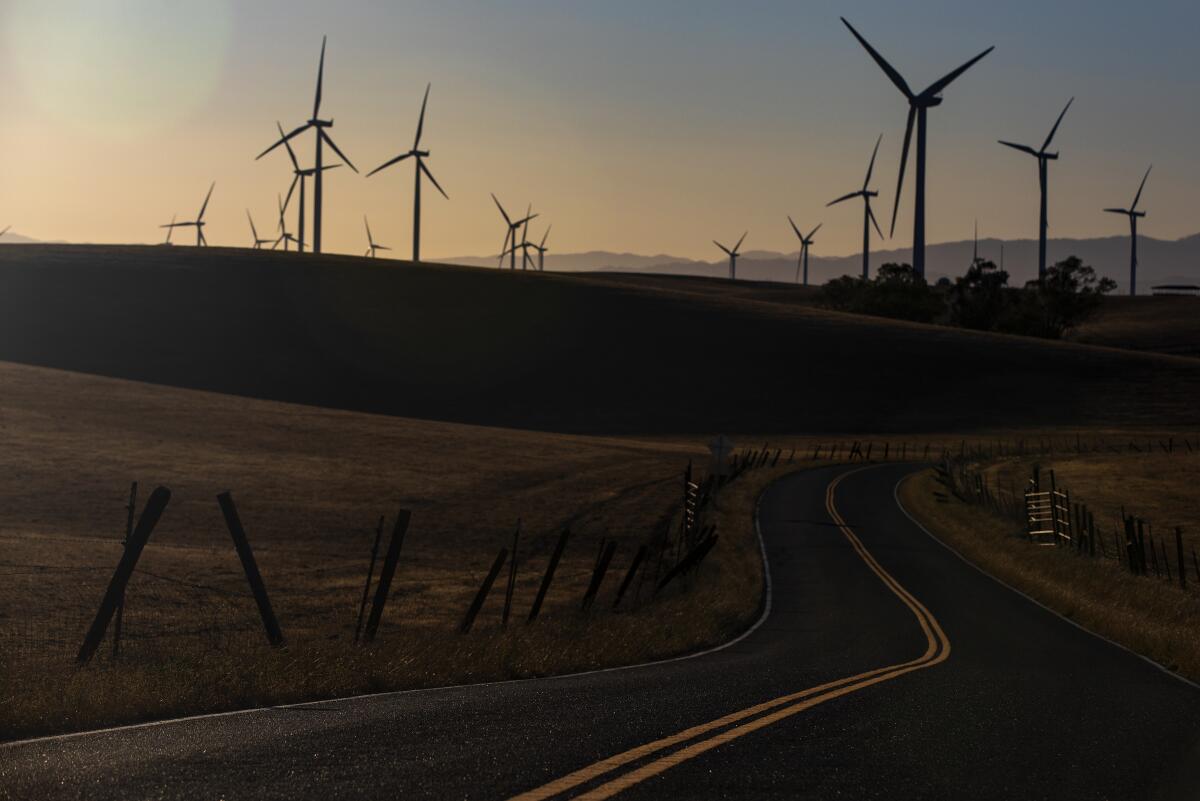
Several readers sounded off on ocean wind turbines — a technology Kelly is familiar with, having scaled towers at America’s first offshore wind farm, in the Atlantic waters off Rhode Island. At least one reader, an avid hiker, was feeling conflicted.
“I firmly support wind and solar development, and the sight of wind and solar in most environments fills me with joy as I realize that we are getting closer to minimizing carbon outputs,” they wrote. “However, the thought of seeing turbines off the coast.... I am TRYING to embrace that for the greater good, but am having trouble doing so.”
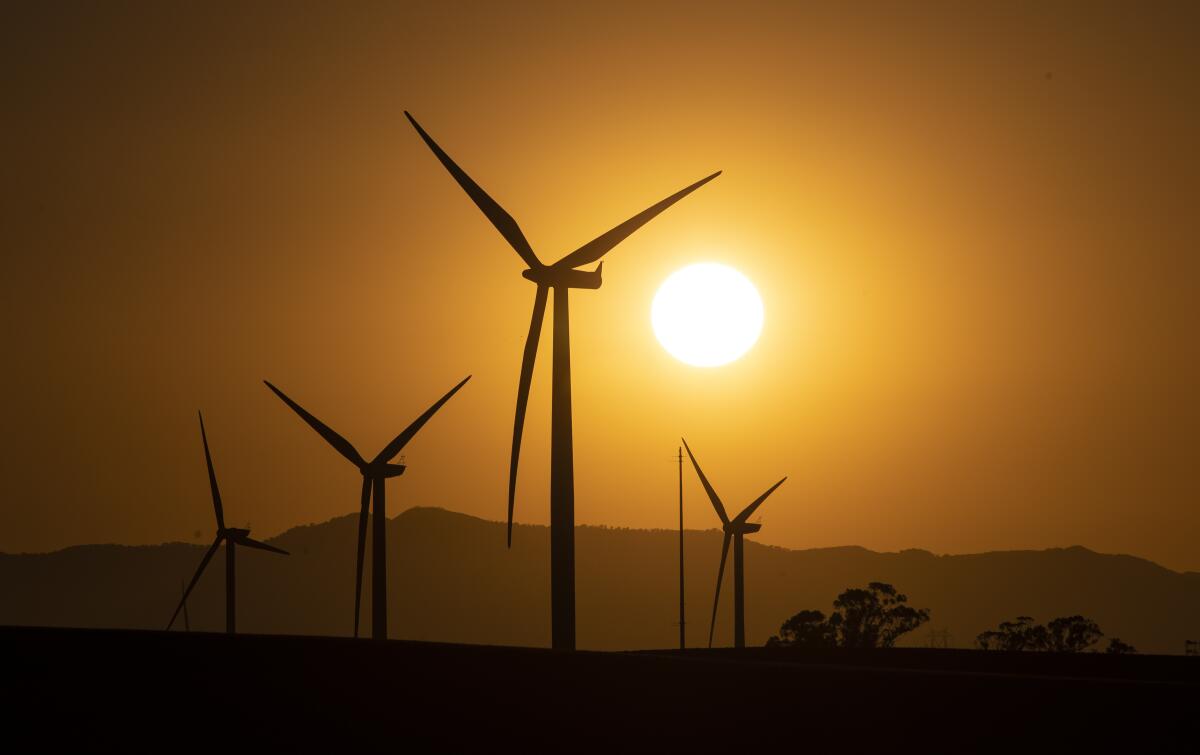
What will the clean energy future look like? Nobody knows for sure. But we do know there are tens of thousands of wind turbines in the United States, and many tens of thousands more planned. Brian’s photos are a good starting point to try to wrap our heads around the visual changes on the horizon, and the jobs behind the transition.
Here’s what else is happening around the West:
TOP STORIES
Native Americans across the West are seeing their cultures imperiled by climate-fueled drought — and sometimes by efforts to fight climate change. My colleague Anita Chabria went to the Klamath Basin, on the California-Oregon border, to talk with tribal members who fear not only for endangered suckerfish but also for their own safety as anti-government extremists threaten to take water for farmers by force; here’s her story. The Nevada Independent’s Daniel Rothberg, meanwhile, wrote about the Indigenous communities whose sources of food and traditional medicine are threatened by a proposed lithium mine.
Last week’s record-breaking heat wave was especially dangerous for outdoor workers, people without homes, and seniors and others who can’t afford air conditioning. The New York Times’ Jack Healy wrote a gripping account of a 115-degree day in Phoenix, focused on construction workers putting their lives at risk and rising housing costs that are pushing people to the streets. The Guardian’s Gabrielle Canon wrote a similar piece about Las Vegas, noting that many of Clark County’s cooling centers close after dark even when overnight temperatures hardly drop — a serious concern in the concrete oasis, and in other big cities.
A stunning investigation finds Gov. Gavin Newsom grossly exaggerated California’s progress on wildfire prevention work ahead of the worst fire year on record. Newsom claimed the state treated 90,000 acres with fuel breaks and prescribed burns as part of 35 “priority projects,” but the actual number was 11,399 acres, CapRadio’s Scott Rodd found. Additionally, the number of acres treated by Cal Fire fell by half in 2020. In the meantime, fires are burning across the West; two national forests in Arizona are closed completely to human visitors, and the Mt. Whitney trailhead is under evacuation orders, The Times’ Hayley Smith reports.
DROUGHT IN THE WEST
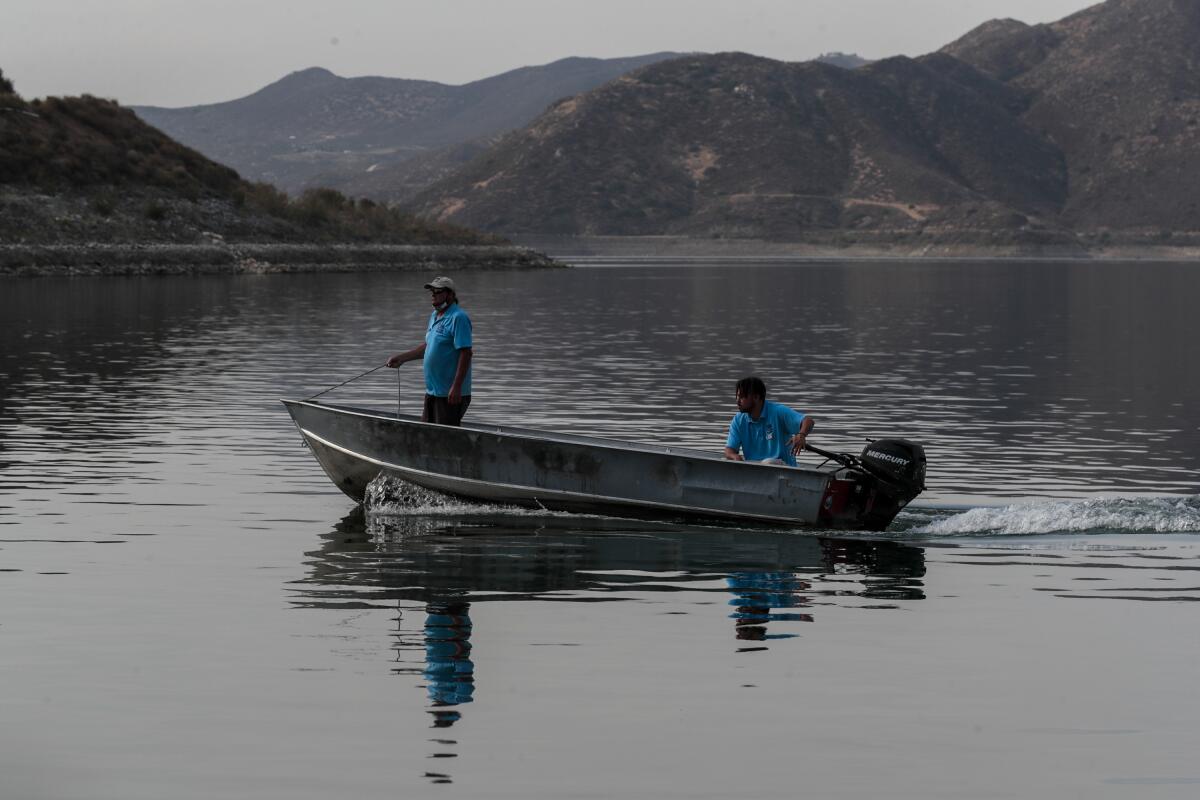
Despite exceptionally dry conditions across the region, Southern California doesn’t appear to be at risk of running out of water anytime soon. Why? In great part because of Diamond Valley Lake, which was built 21 years ago and is still mostly full. My colleague Louis Sahagún wrote about the “inland ocean” that is the Metropolitan Water District’s largest reservoir, with gorgeous photos by Robert Gauthier. And here’s a big-picture Western drought and climate update from The Times’ Celina Tebor.
Native vegetation has declined by 37% across nearly 5,000 square miles of Southern California desert since the 1980s. That’s the finding of a study out of UC Irvine focused on the Sonoran Desert, and it’s especially alarming because desert plants are some of the world’s hardiest. Rising temperatures and reduced rainfall are taking a toll, the Desert Sun’s Janet Wilson reports.
Resolving long-term tensions on the Colorado River won’t be possible without long-term fixes for the Salton Sea, a shrinking lake in the Southern California desert. State officials have focused on patch-up projects to limit public health and environmental damage, but they’re also studying elaborate proposals to pipe in water from Mexico’s Sea of Cortez or the Pacific Ocean, the Desert Sun’s Mark Olalde reports. Whether any of those proposals is actually feasible is a matter of fierce debate.
POLITICAL CLIMATE
We’ve got a nominee for Bureau of Reclamation commissioner. President Biden has tapped Camille Touton to lead the agency, which oversees water and energy systems in the West, the Associated Press reports. She’s a Nevadan who has worked on water for congressional committees and in the Obama administration, and she’ll be a key player on the Colorado River if confirmed.
Gov. Gavin Newsom’s administration has again delayed public health rules meant to protect people living near oil and gas wells. Newsom originally ordered California’s oil regulator, CalGEM, to draft such rules by December 2020. On Dec. 31, CalGEM promised the regulation would be drafted by spring. Now it’s summer, and the agency still has nothing to show, the AP’s Kathleen Ronayne reports. Environmental justice activists continue to demand buffer zones between fossil fuel extraction and homes.
President Biden endorsed a goal of protecting 30% of America’s lands and waters by 2030. But when his Interior Department released the “Conserving and Restoring America the Beautiful” report last month, it suggested lands being farmed, grazed and logged could be counted toward the 30% target, frustrating some conservationists, Wufei Yu reports for High Country News.
Toward a more sustainable California
Get Boiling Point, our newsletter exploring climate change, energy and the environment, and become part of the conversation — and the solution.
You may occasionally receive promotional content from the Los Angeles Times.
THE ENERGY TRANSITION

L.A. traffic is roaring back post-pandemic, bringing with it more lung-damaging pollution and planet-warming emissions. Traffic isn’t quite as bad as it was before, but it may be getting there, even with a public transit expansion in the works, The Times’ Hayley Smith reports. Hayley also covered the groundbreaking for a transit project that will finally link Los Angeles International Airport to the region’s growing rail network. Having driven to the airport in bumper-to-bumper traffic, and taken the shuttle bus, and used rideshare apps, and asked friends and family to drop me off... I personally cannot wait to take the train to LAX.
Wind farms off the California coast would reduce the area available to commercial fishers. That doesn’t necessarily mean they won’t be able to catch as much, but it does mean their costs might rise, Mackenzie Shuman reports for the San Luis Obispo Tribune. This is just one example of the kind of conflict that can slow or derail renewable energy. In Anaheim Hills, for instance, homeowners are fighting a small solar farm over property value concerns, per the Orange County Register’s Alicia Robinson.
I reported last year that Culver City officials were working on a plan to phase out fossil fuel extraction from their portion of the Inglewood Oil Field. By a 4-1 vote last week, the City Council is now moving forward with that plan, which would require all oil drilling to end by 2026, the Culver City Observer reports. Don’t be surprised if the company that owns the oil field files a lawsuit.
ONE MORE THING

I couldn’t help but note that the plot of last week’s episode of “Loki,” the new Marvel TV show on Disney+ — spoiler alert if you haven’t watched yet — hinged on there being repeated climate-related disasters from 2047-2051. Not what I expected!
I also couldn’t help but think back to this piece by my colleague Ryan Faughnder about Disney partnering with Hyundai to produce ads — starring the character Loki — for a compact SUV that runs on oil. You know, one of the major drivers of the climate crisis.
To be fair, Hyundai recently unveiled a plug-in hybrid version of its Tucson compact SUV. And I wrote earlier this year about Disney using “Star Wars” and other popular stories to help Chevrolet sell electric cars. Still, there’s a cognitive dissonance on climate that’s not hard to grasp, and that’s not limited to Disney. For many companies, the gap between words and action is yawning.
Last week’s newsletter referred to the proposed Thacker Pass lithium mine in Nevada facing a setback related to the Endangered Species Act. The proposed mine in question was Rhyolite Ridge.
We’ll be back in your inbox next week. If you enjoyed this newsletter, please consider forwarding it to your friends and colleagues.




